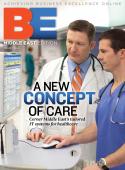More from less┬áKeith Regan learns how long-term partnerships and careful oversight have helped the Indianapolis Public Schools get more bang for the taxpayer buck. The Indianapolis Public School district knew it had long deferred investment in new school buildings and upgrades to its existing facilities. To fulfill part of a long-range strategic plan created in 1999, the district commissioned a facility study in 2000 to find out just how much it would take to create the educational environment it wanted. Working with architecture firm Schmidt Associates, the district arrived at a sweeping $832 million capital improvement program that would touch every facility in the district. To ease the burden on taxpayers, the work was split into phases, with taxpayers initially asked to back a $250 million first phase that focused on adding science labs to all middle schools in the districtÔÇöscience had recently been added to existing testing requirementsÔÇörenovating all high schools and constructing six elementary schools. ÔÇ£We saw that as a way of determining the level of taxpayer support for the initiative,ÔÇØ says Steve Young, chief of facilities planning for the district. ÔÇ£They supported that and have continued to support us as we moved through the program.ÔÇØ The Phase I work was completed in 2006, and the $198 million second phase, which focused on upgrading middle schools, began. Today, IPS is poised to begin seeking bids for the $245 million third phase of work, with Schmidt Associates still on board as the districtÔÇÖs long-term representative and partner. The sweeping building program will revamp the urban district, which today serves about 34,000 children, creating a flexible educational environment that reflects the current thinking about educational programs and spaces as well as the ability to adapt to future innovations, says Deb Kunce, a program manager for Schmidt Associates. ÔÇ£From the start, we set out to build in enough flexibility in the program space. They have changed in the eight-plus years since we began the work, and they will change in the future, but the hallmark of the buildings is that there is enough flexibility to adapt.ÔÇØOver those years, Schmidt has been able to build a strong knowledge base of what the district wants from being involved from the beginning and is now seeing benefits from the slowdowns in the economy and the construction sector in particular. ÔÇ£It has definitely been a plus for us lately. When contractors are hungry for work, we get better bids and more interest,ÔÇØ says Kunce. One recent project that in boom times might have received one or two bids drew 15 highly qualified bidders. ÔÇ£Firms are hungry for work, and in the end that will help taxpayers.ÔÇØThe district has chosen not to utilize the same school design in different areas but has used a basic set of criteria and standards that each individual building is based on. ÔÇ£Each neighborhood has its own character and sense of place, and we wanted to build schools that are sensitive to that while still having consistency and equity across the district in terms of building amenities and program spaces,ÔÇØ Young says. As the building program has unfolded, that core set of design criteria has come to include a heavy emphasis on sustainability and green design elements. The earliest projects did not seek formal certification for their sustainability but were built with long-term energy and maintenance costs in mind. In fact, before work began the district held an energy-focused summit and invited the designers and lead construction managers involved in the work. More recently, the city has embraced the green building movement, and 25 projects in the third phase will pursue certification from the LEED program of the US Green Building Council. Those efforts are already paying off, with a batch of elementary schools that were upgraded to include air conditioning for the first time carrying the same annual operating and maintenance costs as they did before they were upgraded and expanded. ÔÇ£In most cases, we increased square footage and added air conditioning while still reducing operating costs,ÔÇØ notes Young. ÔÇ£ThatÔÇÖs huge,ÔÇØ adds Kunce. ÔÇ£If we can get the designers and engineers to put together a building that saves $40,000 a year in utility costs, the district can hire another teacher. Building in that efficiency makes a real dollar difference when you look at the buildings as a whole.ÔÇØSchmidt has been a valuable partner, says Young. ÔÇ£Once the school board made recommendations to back the program, we also determined for several reasons that we needed an outside firm to help manage it, and because Schmidt had done great work on the survey and study part of the project, the board voted to bring them on in that capacity as well. It has helped give us a lot of consistency and continuity.ÔÇØThe IPS Capital Improvements Program has won several national and international awards, including one for exceptional leadership and project management skills from the Construction Owners Association of America (COAA) in 2005 and the American Society of Heating, Refrigerating and Air-Conditioning Engineers (ASHRAE) Technology Award for one schoolÔÇÖs innovative HVAC system in 2009.┬á For IPS taxpayers, the greatest mark of success is that each phase has been accomplished within the promised budget and timeframe.The long-range test of the building program will of course be student achievement and educational results. ÔÇ£WeÔÇÖve done some measuring of some of the new buildings to look at their impact on educational success and have been able to document that it has made a difference,ÔÇØ says Young. The district also believes that the up-front work done to evaluate needs and lay out a long-term strategic plan has proven invaluable both in keeping work focused on the ultimate goal and in getting taxpayer support for funding the work. ÔÇ£WeÔÇÖve said from the start that we were not just going to start a building program or a program to improve our buildings,ÔÇØ he adds. ÔÇ£The overall focus was to get everyone involvedÔÇöthe designers, the engineers, the contractorsÔÇöto understand the ultimate goal, which is to improve achievement. We stayed focused on that bigger purpose, and when you set that kind of a strategic goal, it goes a long way to help people buy in and support the whole process.ÔÇØ ÔÇô Editorial research by Dan Finn┬á









